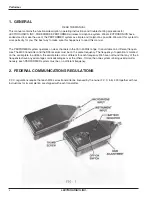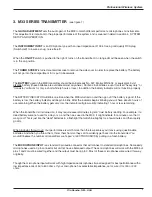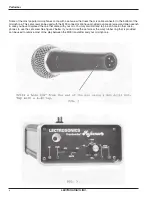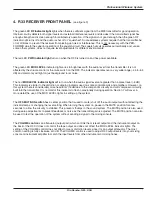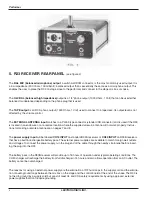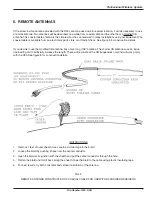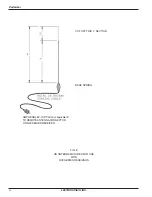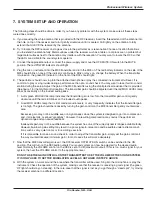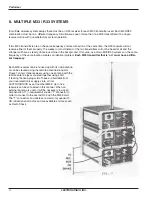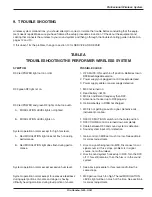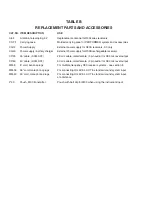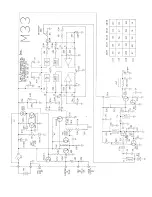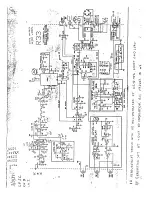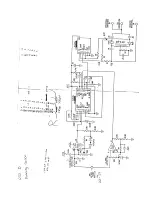
Professional Wireless System
7. SYSTEM SETUP AND OPERATION
The following steps should be done in order. If you have any problems with the system, make sure all these steps
were done correctly.
A. If you are using the whip antenna that is provided with the R33 receiver, insert the threaded end of the antenna into
the hole on top of the receiver and turn it gently clockwise until it is seated. Pull lightly on the antenna to fully
extend it but don’t lift the receiver by the antenna.
B. Try to locate the R33 receiver on stage as close to the performer as is reasonable. Choose a location that allows
you to extend the antenna fully. Metal surfaces under the receiver such as a table or amp rack are no problem but
large metal surfaces next to the antenna may interfere with the reception. You may want to locate the R33 so that
the LEDs are visible to the sound system operator.
C. Connect the appropriate output, connect the power supply and move the OFF-MUTE-ON switch to the MUTE
position. The red POWER indicator should light.
D. Plug the mic or instrument into the M33 transmitter and turn the M33 on. The red battery indicator on the side of the
M33 should blink on once. If the indicator continues to blink or stays on, change the battery. When the transmitter
is turned on, the green RF indicator on the front of the R33 should light.
E. The performer should now sing into the attached microphone or play the connected instrument at full level. It is
common to play or sing louder during a performance than at a sound check. You may want to take this into consid
eration during the setup. Adjust the gain of the M33 transmitter using the small plastic screwdriver that is provided.
(See figure 1 for the GAIN control location.) The transmitter gain should be adjusted until the red MOD LEVEL lamp
blinks occasionally on the loudest audio peaks.
1. A dim green MOD LEVEL lamp indicates the transmitter gain is low. Turn the transmitter gain control gently
clockwise until the red LED blinks on the loudest audio peaks.
2. A red MOD LEVEL lamp that is lit at medium audio levels, or very frequently, indicates that the transmitter gain
is too high. The gain should be reduced by turning the gain control on the M33 transmitter gently counterclock
wise.
Excessive gain may not be audible even on signal peaks since the system is designed to go into compression
and, if all else fails, overload “gracefully”. However, the resulting compression may restrict the performer’s
dynamic range and can cause feedback.
Inadequate gain may not be audible because the system has one of the widest dynamic ranges available today.
However,
too
low a gain setting may result in a poor signal-to-noise ratio and be audible under extreme condi
tions such as very quiet rooms or in recording sessions.
If it is impossible to make a sound check in order to adjust the transmitter gain, simply set the gain control all
the way counterclockwise (minimum gain). In most cases this will work adequately.
F. Now that the M33 transmitter gain is set, the R33 receiver OFF-MUTE-ON switch can be switched to the ON
position. This will turn on the R33 audio outputs. Your sound system can now be adjusted for the desired audio
level. Normally the VOLUME control on the R33 is set at 0 dB (maximum output). If this is too much signal for your
system, then set the VOLUME control to the appropriate level.
DO NOT USE THE GAIN CONTROL ON THE TRANSMITTER TO SET THE VOLUME OF THE SOUND SYSTEM.
IT IS ONLY USED TO SET THE MODULATION LEVEL AS OUTLINED IN STEP E ABOVE.
G. With the system on, walk around the area where the transmitter will be used. Sing into the microphone or play the
instrument. Check the operation of the system, making sure that the receiver is receiving a good signal (the green
RF light should stay on steadily). In the rare case that the signal is lost as you go through a “dead spot”, try moving
the receiver antenna to a different location.
Rio Rancho, NM – USA
11




